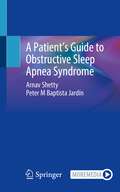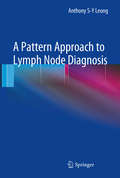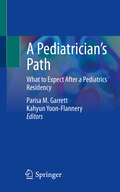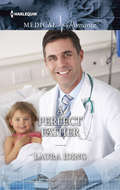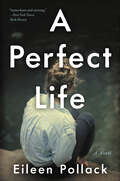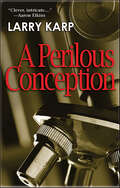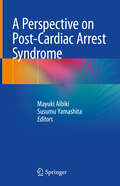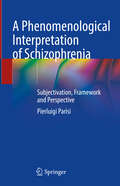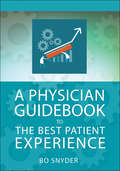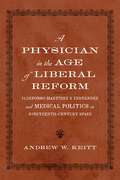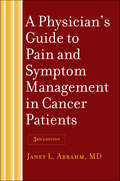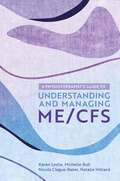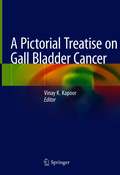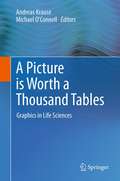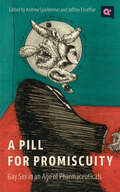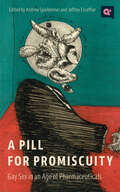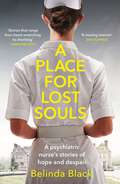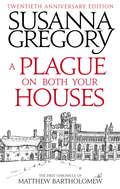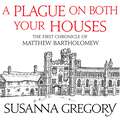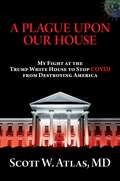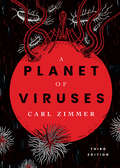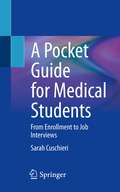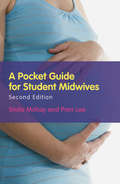- Table View
- List View
A Patient’s Guide to Obstructive Sleep Apnea Syndrome
by Arnav Shetty Peter M Baptista JardínThis book provides a comprehensive overview of Obstructive Sleep Apnea (OSA) that is accessible to patients. OSA can have a significant and progressive impact on the lives of those who suffer from daytime sleepiness, but it is often not considered. Moreover, individuals with the condition are often unaware of it as it affects them during sleep. The book provides knowledge on appropriate pathways for investigation and treatment. The organization and clarity of the writing make it easy for readers who want quick information on diagnosis, symptoms, treatment, and more. The thorough history section covering anatomical evolution, the history of medicine, and modern-day medical and surgical advances will satisfy curious readers. Ample original hand-drawn diagrams increase the readability and approachability of the work, making pathophysiology and surgical procedures clear and accessible. The book also includes links and descriptions of up-to-date procedures, diagnostic techniques, and devices, guiding readers confidently towards other resources beyond the book for further information. Given its features, this guide will appeal also to general practitioners, ENT students, and OSA specialists.
A Pattern Approach to Lymph Node Diagnosis
by Anthony S-Y LeongWhile a pattern approach to diagnosis is taught and practiced with almost every other tissue or organ in the body, the lymph node remains a mystery to most residents starting out in pathology and those pathologists with limited experience in the area. A Pattern Approach to Lymph Node Diagnosis demonstrates that a systematic approach to lymph node examination can be achieved through recognition of morphological patterns produced by different disease processes. It presents a combination of knowledge-based assessment and pattern recognition for diagnosis covering the major primary neoplastic and non neoplastic diseases and metastatic tumors in lymph nodes. This volume demonstrates that lymph node compartments can be recognized histologically especially with the aid of immunohistological markers and how this knowledge can be employed effectively to localize and identify pathological changes in the different compartments in order to facilitate histological diagnosis. It also defines histological features that, because of their pathological occurrence in lymph nodes, are useful pointers to specific diagnoses or disease processes. The volume is organized in accordance with the primary pattern of presentation of each diagnostic entity. Differential diagnosis is discussed and each diagnostic entity is accompanied by color illustrations that highlight the diagnostic features. Immunohistochemistry, clinical aspects, relevant cytogenetics and molecular information of each entity is provided by authors who are experts in lymphoproliferative diseases. An algorithmic approach to diagnosis is adopted at the end of each section by listing a set of questions that help to consider diagnostic entities that can present with the morphological features observed. A Pattern Approach to Lymph Node Diagnosis will be of great utility to residents and fellows in pathology and general pathologists making first hand lymph node diagnoses as well as to hematologists and physicians who treat patients with lymphoprolifeative diseases.
A Pediatrician’s Path: What to Expect After a Pediatrics Residency
by Kahyun Yoon-Flannery Parisa M. GarrettThis book provides a comprehensive review of what comes after the completion of a pediatrics residency. Chapters review several areas of fellowships and how to navigate through the application process, provide a guide for finding a job and negotiating through your first position, and also discuss other difficult topics such as how to deal with malpractice lawsuits. The book is comprised of six parts. Part 1 explains pediatric fellowships, including how to apply, prepare, and choose your ideal fellowship. Part 2 describes what to expect on your first job search and what to consider when choosing a career path. Part 3 and Part 4 aim to prepare readers for what happens after finding and starting a job in pediatrics, such as moving, setting up an office, supervising residents, and how to deal with difficult patients. Part 5 discusses long term goals and planning, which helps prepare readers for the long road ahead. This includes pursuing partnerships, additional degrees, and training. It also shares knowledge on how to manage medical school debt, retirement planning, switching jobs, and much more. Finally, Part 6 aims to help readers maintain their personal health and family life by setting boundaries, managing stress, and discussing ways to avoid burnout.Written by experts in the field, A Pediatrician’s Path: What to Expect After a Pediatrics Residency is a valuable resource for pediatricians, residents and medical students interested in a career in pediatrics.
A Perfect Father
by Laura IdingComing soon! A Perfect Father by Laura Iding will be available Sep 12, 2016.
A Perfect Life: A Novel
by Eileen PollackA research biologist hunts for a genetic disease marker that could hold the key to her fate—and those of two people she loves: “Absorbing.” —Publishers WeeklyA young researcher at MIT, Jane Weiss is obsessed with finding the genetic marker for Valentine’s Disease, a neurodegenerative disorder. Her pursuit is deeply personal—Valentine’s killed her mother, and she and her freewheeling sister, Laurel, could be genetic carriers; each has a fifty percent chance of developing the disease. Having seen firsthand the devastating effect Valentine’s had on her parents’ marriage, Jane is terrified she might become a burden on whomever she falls in love with and so steers clear of romantic entanglement. Then, the summer before her father’s second wedding, Jane falls hard for her future stepbrother, Willie. But Willie’s father also died from Valentine’s, raising the odds that their love will end in tragedy.When Willie bolts at a crucial moment in their relationship, Jane becomes obsessed with finding the genetic marker to the disease that threatens both their families. But if she succeeds in making history, will she and her sister have the courage to face what this newfound knowledge could mean for their lives? A Perfect Life is a thought-provoking, emotionally resonant novel of scientific discovery and self-discovery, about learning how to embrace life and love, no matter what may come. “Highly compelling . . . Pollack’s pacing is dramatic and the story line particularly gripping.” —Paula McLain, New York Times–bestselling author of The Paris Wife “[An] absorbing genetic mystery that is couched in a complicated love story and a tale of survival . . . gritty romance and medical suspense.” —Publishers Weekly“As smart and thought-provoking as it is moving.” —Celeste Ng, New York Times–bestselling author of Little Fires Everywhere
A Perilous Conception: The Detective Baumgartner Mysteries, Book 1 (Detective Baumgartner Mysteries #1)
by Larry Karp1976: Dr. Colin Sanford, a brilliant, ambitious obstetrician practicing in the Pacific Northwest, resolves to become the first to produce a baby by in vitro fertilization, despite the controversy raging over the ethics of artificially-assisted human reproduction. He recruits Dr. Giselle Hearn, an experienced laboratory geneticist-embryologist at the University who's frustrated by the ultra-conservative policies of her department chairman. Working secretly, they set out to put their names in history books. And, incidentally, to cash in.In due course, a Sanford patient, Joyce Kennett, gives birth to a healthy boy. There is rejoicing all around. So why does Joyce's husband erupt in rage, fatally shooting both Hearn and himself? Emerald Police Detective Bernie Baumgartner doggedly seeks the answer. Soon a double cat-and-mouse game develops between the detective who refuses to be bested and the doctor determined to be the best....
A Perspective on Post-Cardiac Arrest Syndrome
by Mayuki Aibiki Susumu YamashitaThis book presents a valuable new perspective on Post-Cardiac Arrest Syndrome (PCAS), which was defined as system failure following whole-body ischemia-reperfusion injuries by the 2008 International Liaison Committee on Resuscitation. Recently, improving the survival rate of PCAS has become a major priority all over the world. A Perspective on Post-Cardiac Arrest Syndrome addresses various aspects, including: neurological outcomes in non-convulsive status epilepticus, target temperature management, interventions for PCAS after acute coronary syndrome, the significance of measuring lactate clearance, a specific scoring system in prognostication for PCAS, therapeutic indications for suicide hanging cases. This book will help a broad readership, including emergency physicians, intensivists, cardiologists and neurologists treating PCAS patients, to understand the history, current issues and future challenges in PCAS, presented by respected experts in this field.
A Phenomenological Interpretation of Schizophrenia: Subjectivation, Framework and Perspective
by Pierluigi ParisiIn this book the author develops a novel, philosophically-psychopathologically founded theory of schizophrenia and its basic disorder. After the introduction with the presentation of the basic concept, the further study is divided into five chapters, each of which first gives a conceptual overview, then includes and analyzes clinical phenomena and research results in detail. The originality and creativity of the work essentially consists in using the terms mentioned as “passe-partout”, as it were, which allow the most diverse, often disparate phenomena and symptoms of schizophrenia to be viewed from an integrating point of view. The method used is phenomenological, descriptive, and interpretative, drawing on a wealth of empirical research results, but at the same time being re-viewed and reorganized in the subjective-perspective framework concept.
A Physician Guidebook to The Best Patient Experience (ACHE Management)
by Robert SnyderProviding a satisfying patient experience is not only the right thing to do—it is the key to clinical and business success. A Physician Guidebook to The Best Patient Experience details the nuts-and-bolts behaviors that produce great physician–patient interactions. It helps physicians tackle the challenge of modifying ingrained behaviors to make changes that stick—and bolster their patient satisfaction scores. An exceptional resource for doctors, this practical guide features checklists, scorecards, assessments, inventories, and questionnaires that can be easily adapted or used as is. The book also includes: An examination of questions from patient satisfaction surveys and the behaviors that can lead to higher scores Practical strategies for making—and sustaining—change, even in the face of the daily whirlwind of activity Advice for using self-assessments, personal scorecards, and input from others to identify personal plans for improvement and track progress Guidance for organizations that wish to support their physicians’ efforts to improve the patient experience Tools for doctors who are undertaking improvement efforts on their own A discussion of the patient satisfaction challenges unique to specific specialties and practice settings A detailed case study illustrating how rapidly patient satisfaction scores can improve—not just for individual physicians but for physician groups too Now available—a companion book for administrators, medical directors, and CEOs Also written by Bo Snyder, The Best Patient Experience: Helping Physicians Improve Care, Satisfaction, and Scores is a roadmap for healthcare leaders who want to help physicians in their organizations improve interactions with patients.
A Physician in the Age of Liberal Reform: Ildefonso Martínez y Fernández and Medical Politics in Nineteenth-Century Spain (New Hispanisms: Cultural and Literary Studies)
by Andrew W. KeittSpanish physicians constituted a crucial political force in the nineteenth century during the tumultuous process of nation-building that followed the War of Independence against the Napoleonic invasion of the Iberian Peninsula. Many participated in the Cortes of Cádiz, which drafted Spain’s first constitution in 1812 and went on to prove highly influential in the public sphere and legislature during the liberal revolution that undertook the establishment of a new, and precarious, political order. Andrew W. Keitt’s A Physician in the Age of Liberal Reform excavates the life and work of one such doctor, Ildefonso Martínez y Fernández, whose brief career coincided with the consolidation of the liberal revolution and the drive to improve and professionalize Spanish medicine. Born in 1821, Martínez was a polymath and activist whose prolific literary and scholarly output made him a fixture in the political and intellectual ferment of midcentury Spain until his untimely death in 1855 during a devastating outbreak of cholera. He produced a significant body of intellectual research, made key contributions to the profession, and cultivated a deep engagement with the political struggles of the period. His impassioned endeavors, as chronicled by Keitt, highlight the efforts of Spanish physicians to mobilize medical science toward forging a new political culture for liberal Spain.
A Physician's Guide to Pain and Symptom Management in Cancer Patients
by Janet L. AbrahmThis highly regarded handbook provides clinicians with the information they need to treat their cancer patients effectively and compassionately.This comprehensive guide to managing pain and other symptoms for people with cancer has helped tens of thousands of patients and families. Designed for busy practicing clinicians, A Physician's Guide to Pain and Symptom Management in Cancer Patients provides primary care physicians, advanced practice nurses, internists, and oncologists with detailed information and advice for alleviating the stress and pain of patients and family members alike. Drawing on the work of experts who have developed revolutionary approaches to symptom management and palliative care, as well as on the lessons learned from patients and their families during her thirty years as a teacher and clinician, Dr. Janet L. Abrahm shows how physicians and other caregivers can help patients and families heal emotionally even as the disease progresses.The third edition includes updates to medications and clinical stories, and features two new chapters: "Working with Patients’ Families" and "Sexuality, Intimacy, and Cancer." New lessons from palliative care and hospice care can help patients, their professional caregivers, and their families support each other every step of the way.
A Physiotherapist's Guide to Understanding and Managing ME/CFS
by Karen Leslie Nicola Clague-Baker Natalie Hilliard Michelle BullMyalgic encephalomyelitis, also known as Chronic Fatigue Syndrome, is a deeply complex and multi-system condition which has historically suffered from a lack of awareness within physiotherapy education and practice. Similarities in presentation between this condition and Long Covid make this comprehensive and evidence-based guide for physiotherapists even more timely and important. This guide includes an in-depth explanation and history of ME/CFS whilst also describing symptoms, varying degrees of severity, and how to manage ME/CFS in children. It also provides detailed management advice and discussion on how the information can directly inform physiotherapy practice, supplemented with patient case studies.
A Pictorial Treatise on Gall Bladder Cancer
by Vinay K. KapoorThis book covers various aspects of gall bladder cancer, e.g. its epidemiology, etiology, pathology, clinical presentation, diagnosis, investigations, staging, management, prevention, etc. Gall bladder cancer is the most common form of biliary tract cancer worldwide, there are peculiar geographical variations in its incidence; while it is rare in the developed west (North America and Western Europe), high incidence rates are reported from Central and South America, Central and Eastern Europe, East Asia (Japan and Korea) and northern India.In addition, the book addresses a number of related issues including thick walled gall bladder, gall bladder cancer with surgical obstructive jaundice, incidental gall bladder cancer, the role and place of common bile duct excision, the Japanese aggressive surgical approach, management of asymptomatic gall stones, etc. An authoritative work that provides detailed insights into various aspects of gall bladder cancer and its management, the book offers a valuable resource for physicians in high-incidence areas and low-incidence areas alike. It is richly illustrated throughout with radiographs (US, CT, MRI, etc.) and operative and specimen photos.
A Picture is Worth a Thousand Tables: Graphics in Life Sciences
by Michael O'Connell Andreas KrauseThis book is devoted to the graphics of patient data: good graphs enabling straight¬forward and intuitive interpretation, efficient creation, and straightforward interpretation. We focus on easy access to graphics of patient data: the intention is to show a large variety of graphs for different phases of drug development, together with a description of what the graph shows, what type of data it uses, and what options there are. The main aim is to provide inspiration in form of a "graphics cookbook." Many graphs provide creative ideas about what can be done. The book is not intended to be technical. It introduces general principles of good visualization to make readers understand the concepts, but the main focus is on the creativity and usefulness: readers are enabled to browse through the book to get ideas of how their own data can be analyzed graphically. For additional information visit Editor's companion website: http://www.elmo.ch/doc/life-science-graphics/
A Pill for Promiscuity: Gay Sex in an Age of Pharmaceuticals (Q+ Public)
by Andrew Holleran Jeffrey Escoffier Kane Race Andrew R. Spieldenner Steve MacIsaac Daniel Felsenthal Nicolas Flores Alex Garner Deion Hawkins Pam Dore Addison Vawters Lore Tta LeMaster Ariel Sabillon Justice Jamal Jones Jeff WeinsteinFor a generation of gay men who came of age in the 1980s and 1990s, becoming sexually active meant confronting the dangers of catching and transmitting HIV. In the 21st century, however, the development of viral suppression treatments and preventative pills such as PrEP and nPEP has massively reduced the risk of acquiring HIV. Yet some of the stigma around gay male promiscuity and bareback sex has remained, inhibiting open dialogues about sexual desire, risk, and pleasure. A Pill for Promiscuity brings together academics, artists, and activists—from different generations, countries, ethnic backgrounds, and HIV statuses—to reflect on how gay sex has changed in a post-PrEP era. Some offer personal perspectives on the value of promiscuity and the sexual communities it fosters, while others critique unequal access to PrEP and the increased role Big Pharma now plays in gay life. With a diverse group of contributors that includes novelist Andrew Holleran, trans scholar Lore/tta LeMaster, cartoonist Steve MacIsaac, and pornographic film director Mister Pam, this book asks provocative questions about how we might reimagine queer sex and sexuality in the 21st century.
A Pill for Promiscuity: Gay Sex in an Age of Pharmaceuticals (Q+ Public)
by Andrew Holleran Jeffrey Escoffier Kane Race Andrew R. Spieldenner Steve MacIsaac Daniel Felsenthal Nicolas Flores Alex Garner Deion Hawkins Pam Dore Addison Vawters Lore Tta LeMaster Ariel Sabillon Justice Jamal Jones Jeff WeinsteinFor a generation of gay men who came of age in the 1980s and 1990s, becoming sexually active meant confronting the dangers of catching and transmitting HIV. In the 21st century, however, the development of viral suppression treatments and preventative pills such as PrEP and nPEP has massively reduced the risk of acquiring HIV. Yet some of the stigma around gay male promiscuity and bareback sex has remained, inhibiting open dialogues about sexual desire, risk, and pleasure. A Pill for Promiscuity brings together academics, artists, and activists—from different generations, countries, ethnic backgrounds, and HIV statuses—to reflect on how gay sex has changed in a post-PrEP era. Some offer personal perspectives on the value of promiscuity and the sexual communities it fosters, while others critique unequal access to PrEP and the increased role Big Pharma now plays in gay life. With a diverse group of contributors that includes novelist Andrew Holleran, trans scholar Lore/tta LeMaster, cartoonist Steve MacIsaac, and pornographic film director Mister Pam, this book asks provocative questions about how we might reimagine queer sex and sexuality in the 21st century.
A Place for Lost Souls: A nurse's stories of hope and despair from a 1980s psychiatric hospital
by Belinda BlackA young psychiatric nurse recalls her eye-opening experiences at one of Britain's secure mental hospitals during the 1980s.'Ultimately, my experiences as a mental health nurse have taught me that we should judge less and open our hearts more.'Belinda Black was just seventeen years old when she began working as a nursing assistant at the large and foreboding 'madhouse', as it was then known to the villagers of her hometown in the north of England. Following in the footsteps of her mother, she went on to spend a decade caring for patients with widely varying mental health problems, all locked up together and out of view of society. They included:Olek - a haunted, diminished and damaged survivor of a Nazi concentration campOrla - whose peaceful demeanour and lovely smile hid a determination to kill herselfAgatha - an extremely violent paranoid schizophrenic with a wonderful sense of humourWarren - who stabbed a person to death after he was let out.But A Place for Lost Souls is also about the other psychiatric nurses there, from those like Sister Kane who suffered from depression and found treating others a welcome distraction, to others like Belinda's friend Sally, who always had a sense of humour however dark the situation.Together, against a backdrop of rattling keys, clanging iron doors, and wards that smelled of disinfectant and stale smoke, these people came together to get through another day. Until the hospital, along with many others, had its doors closed in 1991 - the biggest change to mental healthcare in NHS history.The result is a moving, shocking but ultimately life-affirming account of a unique and noble profession, told from the frontlines. Amongst so much sadness and distress, and despite witnessing some of the darkest corners of human suffering, Belinda finds hope: in the camaraderie of her colleagues, in the patients she cares for, and in her unwavering belief that even people who have committed violent crimes are fundamentally good.(P) 2023 Quercus Editions
A Place for Lost Souls: A nurse's stories of hope and despair from a 1980s psychiatric hospital
by Belinda Black'Ultimately, my experiences as a mental health nurse have taught me that we should judge less and open our hearts more.'Belinda Black was just seventeen years old when she began working as a nursing assistant at the large and foreboding 'madhouse', as it was then known to the villagers of her hometown in the north of England. Following in the footsteps of her mother, she went on to spend a decade caring for patients with widely varying mental health problems, all locked up together and out of view of society. Some had suffered unimaginable trauma, several had violent and volatile tendencies, but amongst this Belinda found moments of joy and even friendship with her patients.Together, against a backdrop of rattling keys, clanging iron doors, and wards that smelled of disinfectant and stale smoke, these people came together to get through another day. Until the hospital, along with many others, had its doors closed in 1991 - the biggest change to mental healthcare in NHS history.The result is a moving, shocking but ultimately life-affirming account of a unique and noble profession, told from the frontlines.
A Plague On Both Your Houses: The First Chronicle of Matthew Bartholomew (Chronicles Of Matthew Bartholomew Ser. #1)
by Susanna GregoryFor the twentieth anniversary of the Matthew Bartholomew series, Sphere reissued the books with beautiful new illustrated covers.-----------------------------Matthew Bartholomew, unorthodox but effective physician to Michaelhouse college in medieval Cambridge, is as worried as anyone about the pestilence that is ravaging Europe and seems to be approaching England. But he is distracted by the sudden and inexplicable death of the Master of Michaelhouse - a death the University authorities do not want investigated. But Matt is determined to get to the truth, leading him into a tangle of lies and intrigue that cause him to question the innocence of his closest friends - and even his family - just as the Black Death finally arrives...A Plague on Both Your Houses is the book that introduced Matthew Bartholomew to the world.
A Plague On Both Your Houses: The First Chronicle of Matthew Bartholomew (Chronicles of Matthew Bartholomew #1)
by Susanna GregoryFor the twentieth anniversary of the Matthew Bartholomew series, Sphere reissued the books with beautiful new illustrated covers.-----------------------------Matthew Bartholomew, unorthodox but effective physician to Michaelhouse college in medieval Cambridge, is as worried as anyone about the pestilence that is ravaging Europe and seems to be approaching England. But he is distracted by the sudden and inexplicable death of the Master of Michaelhouse - a death the University authorities do not want investigated. But Matt is determined to get to the truth, leading him into a tangle of lies and intrigue that cause him to question the innocence of his closest friends - and even his family - just as the Black Death finally arrives...A Plague on Both Your Houses is the book that introduced Matthew Bartholomew to the world.
A Plague On Both Your Houses: The First Chronicle of Matthew Bartholomew (Chronicles of Matthew Bartholomew #1)
by Susanna GregoryFor the twentieth anniversary of the Matthew Bartholomew series, Sphere reissued the books with beautiful new illustrated covers.-----------------------------Matthew Bartholomew, unorthodox but effective physician to Michaelhouse college in medieval Cambridge, is as worried as anyone about the pestilence that is ravaging Europe and seems to be approaching England. But he is distracted by the sudden and inexplicable death of the Master of Michaelhouse - a death the University authorities do not want investigated. But Matt is determined to get to the truth, leading him into a tangle of lies and intrigue that cause him to question the innocence of his closest friends - and even his family - just as the Black Death finally arrives...A Plague on Both Your Houses is the book that introduced Matthew Bartholomew to the world.
A Plague Upon Our House: My Fight at the Trump White House to Stop COVID from Destroying America
by Scott W. AtlasAs seen on Tucker Carlson! What really happened behind the scenes at the Trump White House during the COVID pandemic?When Dr. Scott W. Atlas was tapped by Donald Trump to join his COVID Task Force, he was immediately thrust into a maelstrom of scientific disputes, policy debates, raging egos, politically motivated lies, and cynical media manipulation. Numerous myths and distortions surround the Trump Administration&’s handling of the crisis, and many pressing questions remain unanswered. Did the Trump team really bungle the response to the pandemic? Were the right decisions made about travel restrictions, lockdowns, and mask mandates? Are Drs. Anthony Fauci and Deborah Birx competent medical experts or timeserving bureaucrats? Did half a million people really die unnecessarily because of Trump&’s incompetence? So far no trusted figure has emerged who can tell the story straight—until now. In this unfiltered insider account, Dr. Scott Atlas brings us directly into the White House, describes the key players in the crisis, and assigns credit and blame where it is deserved. The book includes shocking evaluations of the Task Force members&’ limited knowledge and grasp of the science of COVID and details heated discussions with Task Force members, including all of the most controversial episodes that dominated headlines for weeks. Dr. Atlas tells the truth about the science and documents the media&’s relentless campaign to suffocate it, which included canceled interviews, journalists&’ off-camera hostility in White House briefings, and intentional distortion of facts. He also provides an inside account of the delays and timelines involving vaccines and other treatments, evaluates the impact of the lockdowns on American public health, and indicts the relentless war on truth waged by Big Business and Big Tech. No other book contains these revelations. Millions of people who trust Dr. Atlas will want to read this dramatic account of what really went on behind the scenes in the White House during the greatest public health crisis of the 21st century.
A Planet of Viruses: Third Edition
by Carl Zimmer&“A captivating primer to the world of viruses that requires zero background in biology . . . a suitable first introduction to this fascinating part of our world.&” —The Inquisitive Biologist In 2020, an invisible germ—a virus—emerged and wholly upended our lives. We&’ve now become familiar with the new virus that gave us Covid-19—but viruses also cause a vast range of other diseases, including one disorder that makes people sprout branch-like growths as if they were trees. Viruses have been a part of our lives for so long that we are actually part virus: the human genome contains more DNA from viruses than our own genes. Meanwhile, scientists are discovering viruses everywhere they look: in the soil, in the ocean, even in deep caves miles underground. Fully revised and updated, with new illustrations and a new chapter about coronaviruses and the spread of Covid-19, this third edition of Carl Zimmer&’s &“information-packed, superbly readable&” A Planet of Viruses (Booklist, starred review) pulls back the veil on this hidden world. It presents the latest research on how viruses hold sway over our lives and our biosphere, how viruses helped give rise to the first life-forms, how viruses are producing new diseases, how we can harness viruses for our own ends, and how viruses will continue to control our fate as long as life endures. &“Zimmer is one of the best science writers we have today.&” —Rebecca Skloot, New York Times–bestselling author of The Immortal Life of Henrietta Lacks
A Pocket Guide for Medical Students: From Enrollment to Job Interviews
by Sarah CuschieriThis book is addressed to future and enrolled medical students, as well as new graduated doctors, with the main aim to help them getting the grips of what the medical degree is all about and what are the different phases encountered as well as how to survive them. There are various aspects that medical students should be aware of, some “hidden issues” that no one will tell you unless they have passed from the experience themselves. This book will also feature the author’s personal experiences both as a student and a lecturer. This is a unique feature that will enable readers to understand that they are not alone, others have experienced their fears and desires. Readers will be provided with tips on how to survive the course, how to deal with arising issues, and how to balance studying and living a life. This book intends to also highlight the importance of researching during medical school and how to go about it as well as how to prepare CVs and job interviews. An insight into life beyond medical school is also provided. Thanks to the practical and easy-to-use outline – in accordance with various stages from enrolling to preclinical and clinical stages expectations, from targeting work-life balance to conducting research, preparing for a medical job interview and life beyond-, this book will benefit and guide all future medical doctors through their medical school years.
A Pocket Guide for Student Midwives
by Pamela Lee Stella Mckay-MoffatA Pocket Guide for Student Midwives is an accessible, portable book offering student midwives everything they need to grasp the key elements of midwifery language, knowledge and skills.The new edition of this useful aide-memoire is divided into two parts. The first includes relevant terms, abbreviations and definitions. The second part is a quick A-Z reference guide to common conditions, procedures, emergency situations, and supporting information, enhanced by visual material to aid comprehension of normality and anomalies. The innovative action flow charts enable rapid access to information that logically guides the reader through procedures in potentially life-threatening situations, in both home and hospital settings.A Pocket Guide for Student Midwives is essential reading for the new non-nurse student midwife, the experienced nurse entering the midwifery profession, and senior student midwives.
